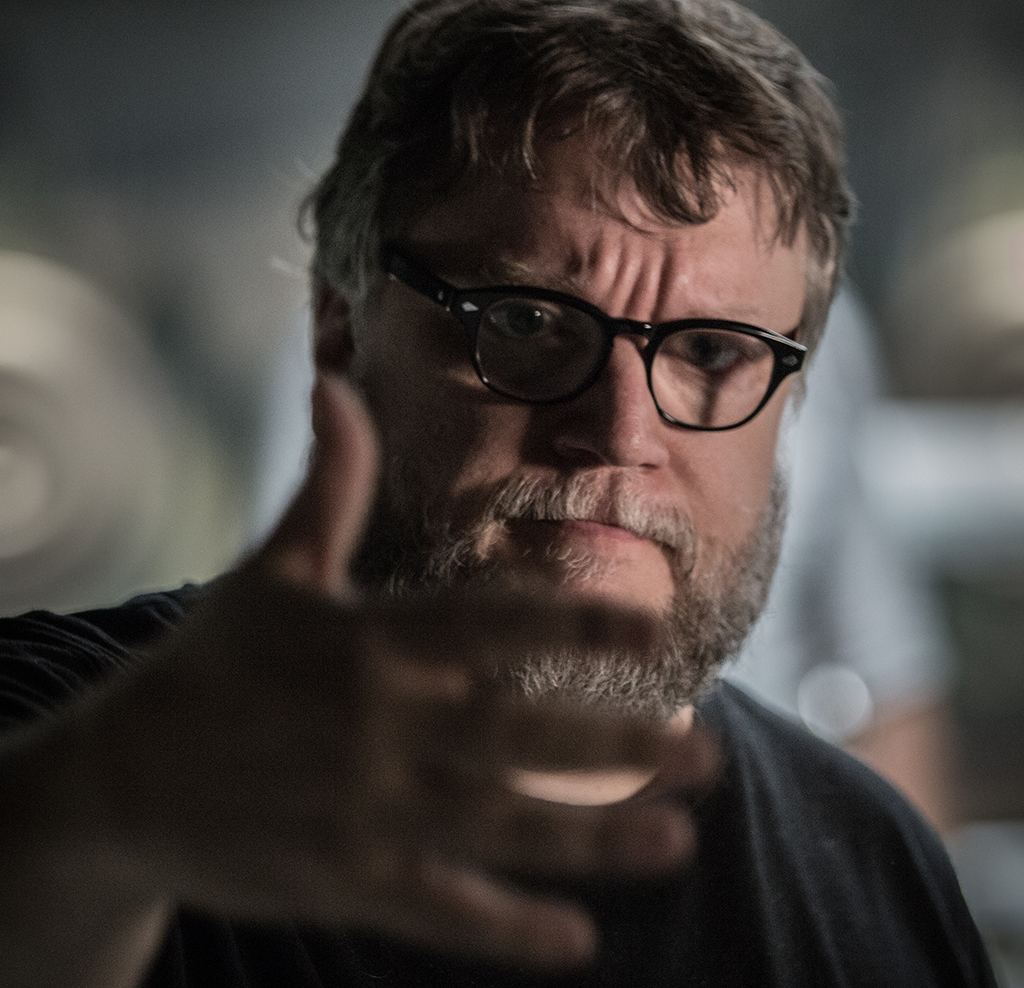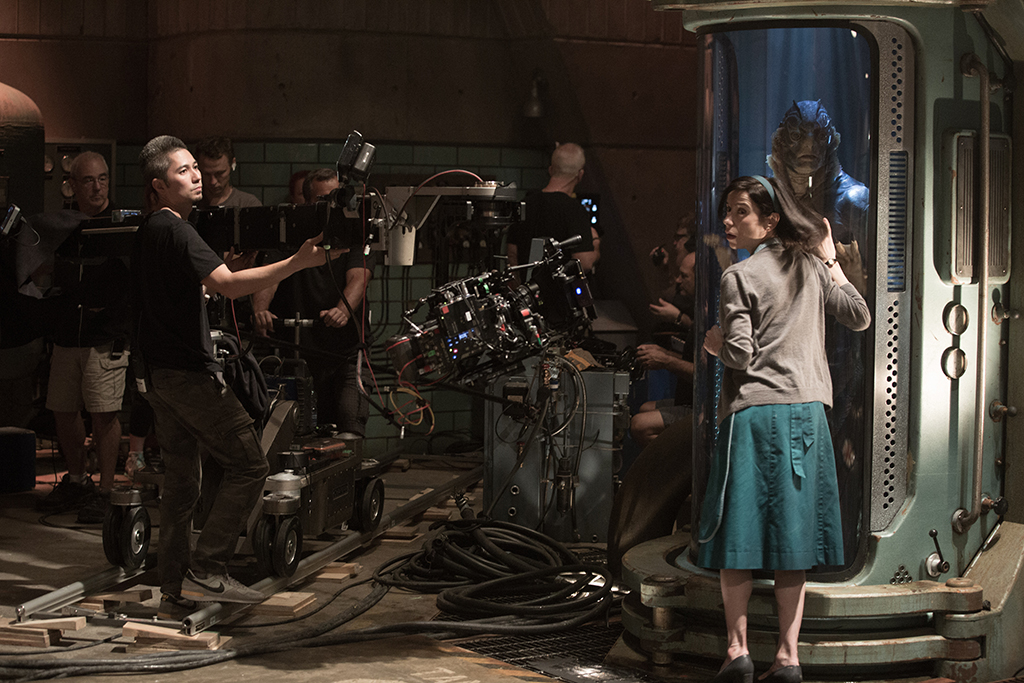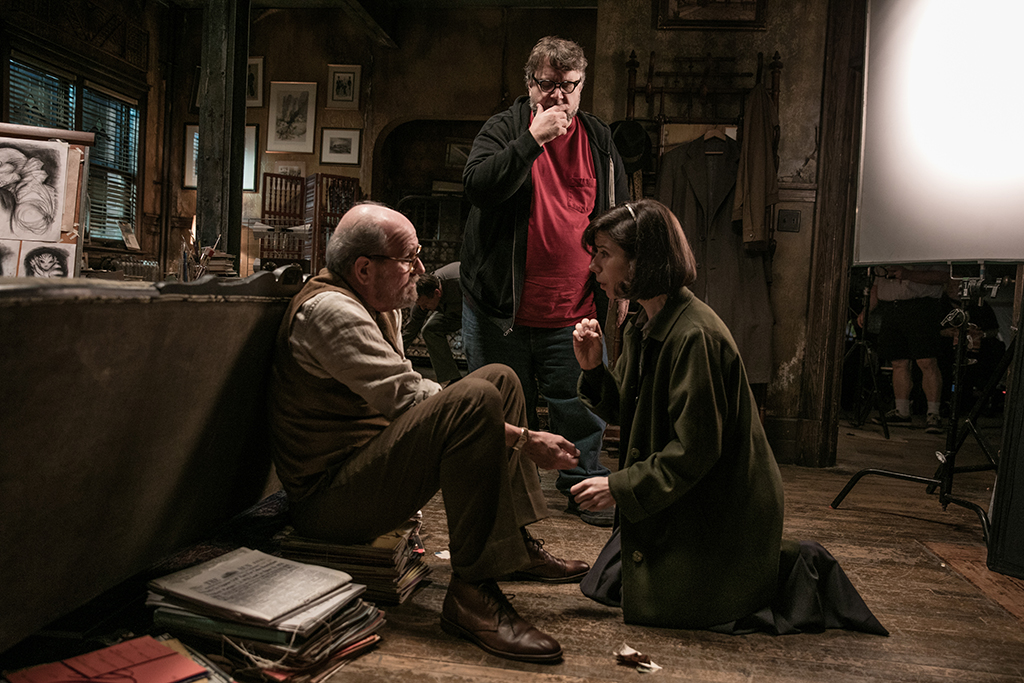For over twenty years, Guillermo del Toro has been at the forefront of filmmakers crafting artistic and intelligent science fiction and fantasy stories. His latest is a first in his celebrated body of work: A uniquely adult, unabashed love story.
The Shape of Water tells the story of what happens when a top-secret project in the Cold War 1960’s brings together two souls who were made for each other: Elisa (Sally Hawkins), a mute custodian in a U.S. government lab, and an unnamed amphibious man (del Toro regular Doug Jones) who is the secret. Through his trademark combination of expressive visuals, emotive storytelling and incredible casting (Hawkins and Jones lead an impressive ensemble that includes Richard Jenkins, Octavia Spencer, Michael Shannon and Michael Stuhlbarg), Del Toro has crafted a romance that transcends genre, that very directly celebrates film (Hawkins and Jenkins’ characters live above a cinema) while at the same time embodying so many reasons why we go to the movies. It also distinctly champions embracing “otherness,” and the discovery of belonging; in one of the film’s most heart-rending moments, Elisa signs a monologue in which she declares her love for a guy with gills by explaining “When he looks at me, the way he looks at me, he never knows I’m incomplete.”
As Del Toro is a favorite of much of our Looter community, we couldn’t pass up a chance to chat with him about The Shape of Water and more, including some terrific pointers for anyone interested in persuing a career in film and some of the other films and shows that have inspired him recently:

Photo by Kerry Hayes. (Fox Searchlight Pictures)
This film carries with it a lot of hallmarks of your body of work, yet is unique within it in many ways. What aspects of this story excited you from a perspective of trying something new?
Well, that was part of the reason I was going to do it. Basically, around the time we were going to start production of the film, I had a moment where I thought to myself, what am I going to try that I haven’t done? And part of it is articulating concerns that I had as an adult. [My] other movies may be adult in nature, like Pan’s Labyrinth and The Devil’s Backbone, but they’re dealing with issues I had as a child, you know? They are rephrasing childhood in a very melancholic way, there’s a sense of loss… and so forth. And on this one, on the other hand, I wanted to make it a celebration. Sort of a love letter to cinema, a love letter to love… make it life-affirming rather than melancholic, and have a sense of gain rather than a sense of loss. All of those things are very different. You know the best way to put it is, after 53 years on this earth, I finally decided to exhale. [laughs]
All of your films have a very emotional through-line to them; I remember speaking to you at Meltdown Comics [in L.A.] several years ago about Pan’s Labyrinth and how that movie really hit me hard. The experience of this one is very different.
Part of the notion I had was that the movie should be like a song. That you come out of this movie humming it, so to speak, rather than just… I find Pan’s Labyrinth devastating, for myself. It’s beautiful, it’s sublime in many ways but it’s also very tough, it’s a tough movie. And when I do escapist movies in a way, be it Hellboy or Pacific Rim or this and that, it’s almost that the more personal films I do [all feel] melancholic and I said, let’s change that. Let’s make something that has, not escapism, but celebration.
One element of The Shape of Water that does feel singular is that you’re telling a very adult love story with a strong fantasy/sci-fi element to it. Why do you think that’s such a rare commodity in genre films?
Particularly, things that deal with a very strong political stance or such in most science fiction films tend to be dystopian. It’s rare to find an adult, hopeful, erotically benign and encompassing tale. The beauty of this story is that it is a celebration of the physical side of love in a very gentle, very humanistic, very encompassing way. And generally when sci-fi marries an intelligent approach, it is a pessimistic approach. So this is rare, and it is rare to do so because I think that it’s a willing act. When auteurs or writers approach reality, they approach it from a critical point of view that doesn’t often include vitalist emotion.
And is that because genre has often provided a window to telling difficult, dark stories where more romantic tales are seen as less challenging? I think of the original Planet of the Apes films being inspired by news clips of race riots, they got away with it then because it was sci-fi.
Listen, I think that the beauty of this is that if you’re talking about art, empathy, “the other” or a love story, with The Shape of Water you’re doing so through a fable. The fantastic elements in it allow you to discuss without getting mired by the banality of front-page news or politicking, you know?
The creature effects in your films consistently have an organic tangibility to them, even when there is CGI involved. How did the balance pan out between on-set and digital FX in this film?
The balance is in favor of the physical by a huge margin. The creature is what you see on set, it was an incredibly elaborate suit and makeup effects approach that took three years: Two years to design and one to construct, paint and sculpt. It’s the same reason I favor real sets, because you get the sense of a hand-made film. There’s an artisanal beauty to what the lens captures physically that is, in my opinion, superior to the digital extension of a set or the digital creation of a creature. You have a real performer inside, you’re not correlating animation and captured data.

Sally Hawkins and Doug Jones on set. Photo by Kerry Hayes. (Fox Searchlight Pictures)
Your film is getting a huge amount of praise as one of the best of this year. We’d love to know, what are the films and TV shows that excited you most this year?
I try to keep pretty current, I think that lately the last few years I’m addicted to documentaries, really. In a way they have evolved to be incredibly compelling, like Making a Murderer. And at the same time there are so many TV series: Black Mirror, Stranger Things, Mindhunter, that activate so many things that are proper and good for long arc TV, which is an art form in itself, very different from film. I’m happy to visit those. In comedy, I discovered only recently – thanks to my kids – Brooklyn Nine-Nine, which is tremendous. What I love is how gentle its spirit is: It’s very humanistic and healing almost, the good nature and the warmth of the characters. And in terms of movies, I can think that I’m as excited for the re-release of a good transfer of a 30s-40s-50s movie as I am for the new releases.
It’s funny you should mention both comedy and documentaries, one of the funniest shows on TV right now is – have you seen Documentary Now?
No, not yet I haven’t.
Oh it’s great, Fred Armisen and Bill Hader, on IFC. If you’re a real nerd about documentaries, their attention to detail parodying stuff like Grey Gardens and Stop Making Sense is incredible and it’s so funny.
Bill Hader is a such genius. And he’s so good in drama too, when you see him in something like The Skeleton Twins. There’s a thing that I believe in which is that great comedic actors can be great dramatic actors, almost infallably.
Well, and you had a particular experience yourself like that, with Sergi Lopez [who played the Captain in Pan’s Labyrinth].
Yeah, yeah. He is – no pun intended, I mean this literally – he went to clown school in Paris for physical comedy. And he is tremendous as a dramatic actor.
One thing I definitely noted in The Shape of Water, throughout your storytelling there are certain archetypes that you seem to be fascinated by and I noted a lot of similarities between the captain in Pan’s and Strickland (Michael Shannon) in this film.
Yes, there is, and the male antagonist in The Devil’s Backbone. They would all go and have a horrible coffee together. [laughs] But the funny thing is that with time and the more I age as a filmmaker, I am more compelled by giving them two or three scenes where you actually see their side. There are a few scenes in The Shape of Water where Shannon really makes you feel his plight as a character, that he is not successful particularly and he is under pressure himself. He is a tortured character and you understand why, but without diminishing his efficiency as tremendous force to go against.
And that’s one thing that’s very compelling in your films is that, the most human villains are usually the most terrifying.
It is true. Especially now.

Del Toro directs Richard Jenkins (Giles) and Sally Hawkins. Photo by Kerry Hayes. (Fox Searchlight Pictures)
For our readers who are studying film, or are interested in filmmaking: What are the universal aspects of your craft that you feel apply to everything you do, whether it’s a period love story like this or a big, futuristic action film like Pacific Rim?
Well, the same very, very careful and minute color-coding, texture and shape coding, the same impulse… to use audio-visual language to tell the story, other than just the screenplay. [The type of] dramturgy that you can share with theater and TV, you can use to tell the very language of film, and tell the story. When we color-code we do so for content, you know? Not for looks. We assign each color in the palette a specific reason to be there. For example, in The Shape of Water, blues and cyans are [Elisa’s] apartment, because she’s a creature of the water. Every other living space – Zelda, Giles, Strickland – all of them are color coded for daylight, in ambers, oranges, yellows. They immediately exude daylight. We use green for the future, very pointedly, even in the dialogue. And then we use red for love and cinema: Only for the theater seats, the theater door, and her clothing once they fall in love. And I could walk you through a very different use of the same colors for example in Crimson Peak: red signifies the past, the warm colors are for America, the cool colors are for the old world.
Are there films, or even artists, that have used a similar strong approach to color or light that you feel influenced you in a big way?
The moment I felt it gelled was very early on when I was a kid, I read an interview with Fellini. He said, very pointedly, “When I went from black and white to color, I wanted to make color tell the story. I wanted it to count for something.” And I thought, that’s true, and the same applies to light, color, texture, everything. Every time you’re using an audio-visual grammar, there are directors that use it almost in a casual way, and there are those that use it in a painterly way. And when I say “painterly,” I don’t mean “pleasant.” But actually, as part of the energy of the painting. If you have a sunset by Van Gogh, and a sunset by Turner, and a sunset by a classical painter, they will be completely different, and they could be depicting the same moment. The thickness of the paint, the boldness of the stroke… the color palette they use. They are read in a way that we don’t read film, but I try to write it in that way. I try to write it in a painterly way.
The Shape of Water is now open in exclusive release in New York, and will open in more cities in limited release this Friday, December 8th.



